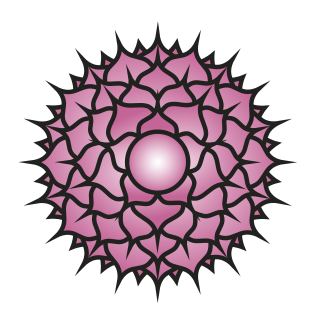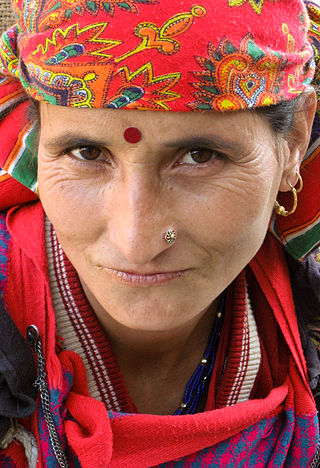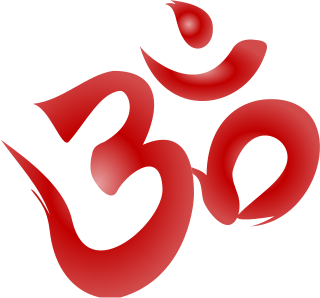
Chakras are various focal points used in a variety of ancient meditation practices, collectively denominated as Tantra, or the esoteric or inner traditions of Hinduism and Buddhism.

Charles Webster Leadbeater was a member of the Theosophical Society, Co-Freemasonry, an author on occult subjects, and the co-initiator, with J. I. Wedgwood, of the Liberal Catholic Church.

A subtle body is a "quasi material" aspect of the human body, being neither solely physical nor solely spiritual, according to various esoteric, occult, and mystical teachings. This contrasts with the mind–body dualism that has dominated Western thought. The subtle body is important in the Taoism of China and Dharmic religions such as Hinduism, Buddhism, and Jainism, mainly in the branches which focus on tantra and yoga, where it is known as the Sūkṣma-śarīra. However, while mostly associated with Asian cultures, non-dualistic approaches to the mind and body are found in many parts of the world.

Ajna, brow or third eye chakra, is the sixth primary chakra in the body according to Hindu tradition and signifies the unconscious mind, the direct link to Brahman. The third eye is said to connect people to their intuition, give them the ability to communicate with the world, or help them receive messages from the past and the future.

Sahasrara or the crown chakra is considered the seventh primary chakra in some yoga traditions. The chakra is violet in colour.
The following outline is provided as an overview of and topical guide to spirituality:

Dantian is a concept in traditional Chinese medicine loosely translated as "elixir field", "sea of qi", or simply "energy center". Dantian are the "qi focus flow centers", important focal points for meditative and exercise techniques such as qigong, martial arts such as tai chi, and in traditional Chinese medicine.

A bindi known as pottu and teep is a coloured dot or, in modern times, a sticker worn on the center of the forehead, originally by Hindus, Jains, Buddhists, and Sikhs from the Indian subcontinent.

Root races are stages in human evolution in the esoteric cosmology of theosophist Helena Petrovna Blavatsky, as described in her book The Secret Doctrine (1888). These races existed mainly on now-lost continents. Blavatsky's model was developed by later theosophists, most notably William Scott-Elliot in The Story of Atlantis (1896) and The Lost Lemuria (1904). Annie Besant further developed the model in Man: Whence, How and Whither (1913). Both Besant and Scott-Elliot relied on information from Charles Webster Leadbeater obtained by "astral clairvoyance". Further elaboration was provided by Rudolf Steiner in Atlantis and Lemuria (1904). Rudolf Steiner, and subsequent theosophist authors, have called the time periods associated with these races Epochs.

Rick Strassman is an American clinical associate professor of psychiatry at the University of New Mexico School of Medicine. He has held a fellowship in clinical psychopharmacology research at the University of California San Diego and was Professor of Psychiatry for eleven years at the University of New Mexico. After 20 years of intermission, Strassman was the first person in the United States to undertake human research with psychedelic, hallucinogenic, or entheogenic substances with his research on N,N-dimethyltryptamine, also known as DMT. He is also the author of DMT: The Spirit Molecule, which summarizes his academic research into DMT and other experimental studies of it, and includes his own reflections and conclusions based on this research.
The mental body is one of the subtle bodies in esoteric philosophies, in some religious teachings and in New Age thought. It is understood as a sort of body made up of thoughts, just as the emotional body consists of emotions and the physical body is made up of matter. In occult understanding, thoughts are not just subjective qualia, but have an existence apart from the associated physical organ, the brain.

Theosophical teachings have borrowed some concepts and terms from Buddhism. Some theosophists like Helena Blavatsky, Helena Roerich and Henry Steel Olcott also became Buddhists. Henry Steel Olcott helped shape the design of the Buddhist flag. Tibetan Buddhism was popularised in the West at first mainly by Theosophists including Evans-Wentz and Alexandra David-Neel.
Causal plane is a term used in Neo-Theosophy, some contemporary Vedanta, the New Age,, and sometimes Occultism, to describe a high spiritual plane of existence. However, there is great variation between the different definitions.

Higher consciousness is a term that has been used in various ways to label particular states of consciousness or personal development. It may be used to describe a state of liberation from the limitations of self-concept or ego, as well as a state of mystical experience in which the perceived separation between the isolated self and the world or God is transcended. It may also refer to a state of increased alertness or awakening to a new perspective. While the concept has ancient roots, practices, and techniques, it has been significantly developed as a central notion in contemporary popular spirituality, including the New Age movement.

In Theosophy, Maitreya or Lord Maitreya is an advanced spiritual entity and high-ranking member of a reputed hidden spiritual hierarchy, the Masters of the Ancient Wisdom. According to Theosophical doctrine, one of the hierarchy's functions is to oversee the evolution of humankind; in concert with this function Maitreya is said to hold the "Office of the World Teacher". Theosophical texts posit that the purpose of this Office is to facilitate the transfer of knowledge about the true constitution and workings of Existence to humankind. Humanity is thereby assisted on its presumed cyclical, but ever progressive, evolutionary path. Reputedly, one way the knowledge transfer is accomplished is by Maitreya occasionally manifesting or incarnating in the physical realm; the manifested entity then assumes the role of World Teacher of Humankind.

The Yoga-kundalini Upanishad, also called Yogakundali Upanishad, is a minor Upanishad of Hinduism. The Sanskrit text is one of the 20 Yoga Upanishads and is one of 32 Upanishads attached to the Krishna Yajurveda. In the Muktika canon, narrated by Rama to Hanuman, it is listed at number 86 in the anthology of 108 Upanishads.

The Hamsa Upanishad is a Sanskrit text and a minor Upanishad of Hinduism. It is classified as one of the twenty Yoga Upanishads, and attached to the Shukla Yajurveda. The text or parts of the text is a relatively late origin, probably from the 2nd-millennium of the common era, but written before early 17th-century, because Dara Shikoh included it in the Persian translation of the Upanishads as Oupanekhat, spelling it as Hensnad (Hamsa-nada).

Theosophy is a religion established in the United States during the late 19th century. It was founded primarily by Helena Blavatsky and draws its teachings predominantly from Blavatsky's writings. Categorized by scholars of religion as both a new religious movement and as part of the occultist stream of Western esotericism, it draws upon both older European philosophies such as Neoplatonism and Indian originated religions such as Hinduism and Buddhism.

Hinduism is regarded by modern Theosophy as one of the main sources of "esoteric wisdom" of the East. The Theosophical Society was created in a hope that Asian philosophical-religious ideas "could be integrated into a grand religious synthesis." Prof. Antoine Faivre wrote that "by its content and its inspiration" the Theosophical Society is greatly dependent on Eastern traditions, "especially Hindu; in this, it well reflects the cultural climate in which it was born." A Russian Indologist Alexander Senkevich noted that the concept of Helena Blavatsky's Theosophy was based on Hinduism. According to Encyclopedia of Hinduism, "Theosophy is basically a Western esoteric teaching, but it resonated with Hinduism at a variety of points."















